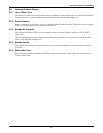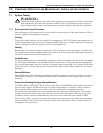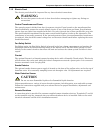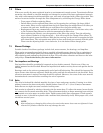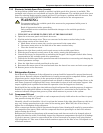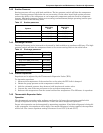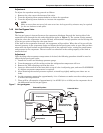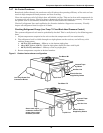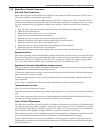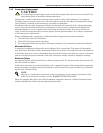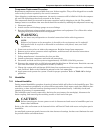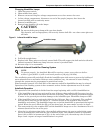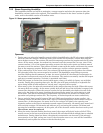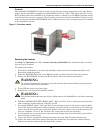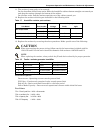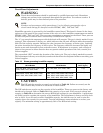
Component Operation and Maintenance, Checks and Adjustments
55
7.4.8 Water/Glycol Cooled Condensers
Shell and Tube Condensers
Each water or glycol cooled module has a shell and tube condenser which consists of a shell, remov-
able heads, gaskets and cleanable copper tubes.
It may be necessary to clean the copper tubing periodically to remove any scale or lime that should
collect (periods between cleanings will vary with local water conditions). As deposits build up, a clean-
ing tool, available at any refrigeration supply house, should be used to clean the heat exchanger
tubes.
1. Stop the unit (using the start/stop switch) and allow the compressor to pump down.
2. Open the disconnect switch.
3. Shut off the water supply valve to the condenser.
4. Drain the water from condensers and piping.
5. Remove the bolts securing each head and slowly pry them free.
6. Remove old gaskets and inspect sealing surfaces for pits and corrosion.
7. Swab the condenser tubes with a tube cleaning tool.
8. When the tubes are clean, reinstall the heads using new factory gaskets.
9. Consult factory for specific torque requirements.
10. Reconnect the piping, open water supply valve, vent the system and check for leaks.
Regulating Valves
The water regulating valves automatically regulate the amount of fluid necessary to remove the heat
from the refrigeration system, permitting more water to flow when load conditions are high and less
fluid to flow when load conditions are low. The valve consists of a brass body, balance spring, valve
seat, valve disc holders, capillary tube to discharge pressure, and adjusting screw.
Adjustment (Johnson Controls/Penn Johnson valves)
The valves may be adjusted with a standard refrigeration service valve wrench or screwdriver. Refer
to Table 16 for recommended refrigerant pressures.
To lower the head pressure setting, turn the square adjusting screw clockwise until the high pressure
gauge indicates the desired setting.
To raise the head pressure setting, turn the adjusting screw counterclockwise until the desired set-
ting is obtained.
If your unit is equipped with valves from other manufacturers, please consult the factory.
Testing Function of Valve
First, turn off the refrigeration system.
When the refrigeration system has been off for approximately 10 to 15 minutes, the water flow should
stop.
If the water continues to flow, the valve is either improperly adjusted (with head pressure too low) or
the pressure sensing capillary is not connected properly to the condenser.
Glycol Solution Maintenance
It is difficult to establish a specific schedule of inhibitor maintenance since the rate of inhibitor deple-
tion depends upon local water conditions. Analysis of water samples at time of installation and every
six (6) months should help to establish a pattern of depletion. A visual inspection of the solution and
filter residue is often helpful in judging whether or not active corrosion is occurring.
The complexity of water-caused problems and their correction makes it important to obtain the advice
of a water treatment specialist and follow a regularly scheduled maintenance program.
Proper inhibitor maintenance must be performed in order to prevent corrosion of the glycol system.
Consult glycol manufacturer for testing and maintenance of inhibitors. Do not mix products from dif-
ferent manufacturers.



